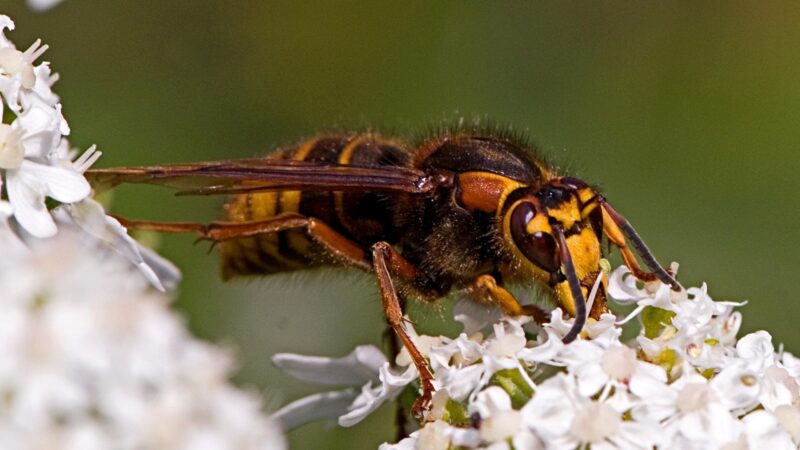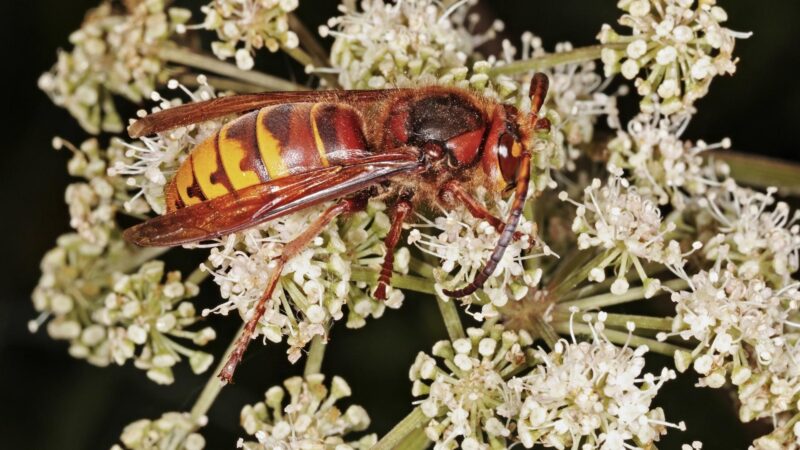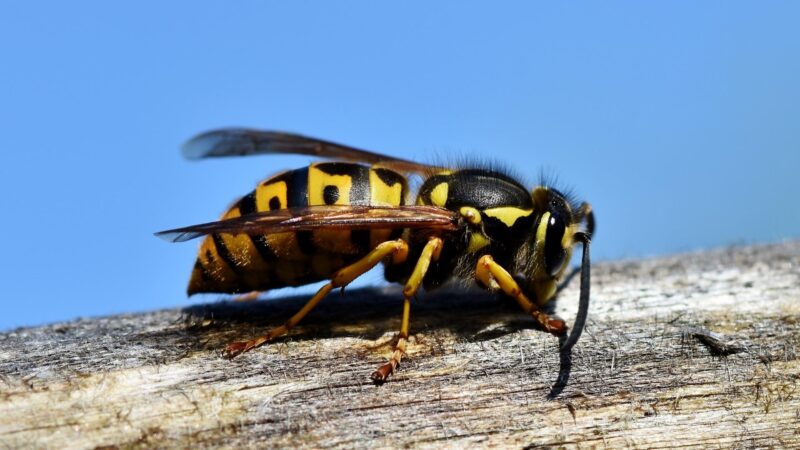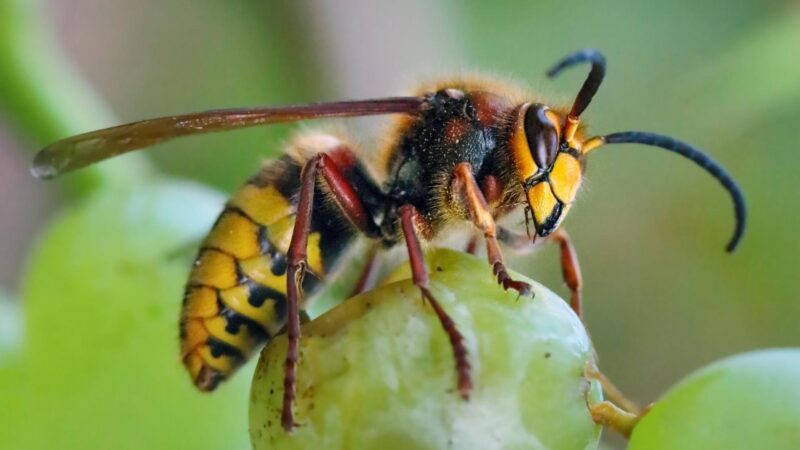Unlike other bees that only sting once, the European hornet stings multiple times. What’s worse is that it ejects a chemical scent called pheromone, which alerts other hornets to attack.
So, what happens if you get stung by a large European hornet? If you get stung by a European hornet, you will experience burning pain, inflammation, raised lump, and redness around the pricked area. The venom has toxins that can induce allergic responses in people who are allergic to the stings of bees.
By reading this guide, you will know more about European hornets, including their characteristics, first-aid treatment, and ways to get rid of them. So, let’s get started!
What Are European Hornets?

European hornets are the largest social wasp. They live in colonies containing 200 to 400 associates during their peak. You can typically see them during late summer. They nest in barns, hollow trees, attics, and deserted beehives.
What Does a European Hornet Look Like?
Hornets are multicolored with yellow or white stripes that counter against their black and brownish-red bodies. Their eyes are profoundly indented, has a C-like shape with reddish-orange wings, and striped yellow and brown petiolate abdomen.
Furthermore, European hornets’ thorax and abdomen are hairy but not as hairy as most bees, like the honeybees. Females are generally larger than males, and only they have stingers, which means only female hornets are able to sting.
Additionally, their heads have a lighter color, and they have antennae, large dark eyes with six legs, and two wings. Their stinger is located at the end of their body, connecting to a gland containing the venom. Their size ranges from ¾ of an inch to 1 ½ of an inch.
Are European Hornets Rare in the US?
The European hornets are becoming a more common sight in the U.S, particularly in Eastern North America. However, they are still considered an endangered species since their nests are often destroyed due to people’s fear of getting stung.
What Do European Wasps Eat?
European wasps’ diet includes eating meat or vegetable scraps, pet food, dead insects, or fish. They prey on flies, grasshoppers, honey bees, yellow jackets. They also consume fruits, tree sap, and honeydew.
What to Do if a Hornet Bites You?

This varies based on the stringency of the case. For mild cases, you can treat the sting by yourself, as follows:
- Clean the pricked site thoroughly with soap and water.
- Apply a cold compress to the stung site to numb the pain and lessen swelling.
- If you have been pricked on the arm or leg, try to elevate it to subside the swelling.
- Apply or take over-the-counter medicines, such as antihistamines to ease the symptoms around the sting site.
Do Hornets Sting for No Reason?
No, they only sting if they are provoked or unintentionally bothered in their nest. They will protect themselves by stinging if they feel threatened. If you end up troubling an entire nest and get stung several times, it’s best to seek immediate medical attention.
What Does a Hornet Bite Look Like?
You’re likely to have a raised lump around the sting site and a minuscule white mark visible in the middle of the bump, where the hornet pierced your skin. It’s around ½ inch in size and may swell for up to 2 inches in the succeeding days.
How Bad Is the Sting From a European Hornet?
Although the sting is quite painful, their stings rarely induce severe problems. However, their venom has toxins, causing allergic reactions in sensitive people. Roughly 1 in 10 people who are pricked two or more times are allergic—meaning they will experience severe responses to any succeeding stings.
How Do You Know If You Get Stung by a Hornet?
If you get stung by a hornet, you will feel almost instant pain at the sting site. It will be accompanied by a sharp, burning sensation that typically lasts only a few seconds. However, the red-swollen welts can get worse within 48 hours right after the sting and can last for a week.
How Long Does a European Hornet Sting Last?
The severity of pain or the burning sensation at the stung site can last from 1 to 2 hours. Regular swelling from venom can rise for 48 hours after the sting. The stung site’s redness can stay for 3 days, while the swelling can prevail for up to 7 days.
Are Hornet Stings Awful Than Wasps?

Though they both nest similarly, hornets are well-known to be lesser hostile than wasps when not provoked. In addition, their stings are much worse to experience than usual wasp stings due to the chemicals they hold.
Unlike other bees, which can only sting one time, hornets can also attack multiple times. This is because hornets have smooth stingers, while the other bees have a barbed stinger that can’t be pulled away without ripping out their abdominal tissues.
Can European Hornets Kill You?

Although European hornets’ sting is quite painful due to the venom they secrete and the multiple stings they can do, it’s not true that they can kill. However, if you are allergic to bee stings, immediate treatment is required if pricked multiple times to avoid adverse effects.
How to Treat European Wasp Sting?
For less severe stings, you can treat the European wasp sting by:
- Wash the stung site with mild soap and warm water.
- Put a cold pack on the pricked site to subside the swelling and reduce the pain.
- Use pain-relieving prescriptions and creams.
- Be watchful for signs of anaphylaxis.
Seek urgent medical attention if:
- A kid is stung more than five times.
- A grown-up is stung more than ten times.
- If anyone is stung in the throat or mouth since the swelling in these sites can block the airways.
- If you have a history of allergic responses to European wasp stings.
Related: What to Do With a Wasp Sting? | All You Need to Know!
What to Do if You Find a European Hornet?
It’s best to call a licensed pest control expert to handle the issue. Do-it-yourself removal of European hornets is not advised as it can get too dangerous. You will need the right equipment and expertise to solve the problem thoroughly, so it’s always best to leave it in the hands of professionals.
How to Get Rid of European Hornets?
Noticing big-size worker European hornets buzzing around your property is a sign of infestation. Nests are commonly found in areas such as hollow trees, attics, porches, and inside wall voids.
Control their number by applying a pesticide directly into the nest at dusk. Know that this is best done by a licensed pest control expert. However, if you think you can handle this task, you can proceed at your own risk. Make sure that you are wearing protective clothing and equipment.
Use any wasp and hornet aerosol that can propel insecticide up to 15 feet. Here are some good products you can try:
- INSECTS KILLED: Kills wasps, hornets and yellowjackets, as well...
- UP TO 27 FOOT JET SPRAY: Stand a safe distance from the nest...
- ELIMINATES THE NEST: Wait at least 24 hours before removing...
- POWERFUL SPRAY: Kills insects that return to the nest over the...
- WHEN TO APPLY: Apply at sunset when insects are least active and...
- FAST KNOCKDOWN: Kills wasps, hornets, yellow jackets and mud...
- JET SPRAY: This product reaches nests up to 20 feet away
- ELIMINATES THE NEST: SpectracidePRO Wasp & Hornet Killer kills...
- OUTDOOR USE ONLY: Dielectric breakdown voltage of 47,300 volts
- WHEN TO APPLY: Apply at sunrise or sunset when insects are least...
- Kills wasps, hornets, yellow jackets and bees on contact
- High output 20 foot jet blast
- High dielectric strength of 47,300 volts
- Kills with residual action as wasps and hornets return to their...
- Safe on most plastics
To apply, spray directly to the nest entrance for about 5 to 10 seconds. After that, move as fast as you can away from the area to avoid the hornets emerging from their disturbed nest.
You may need to do this again the following evening until these hornets decide to leave your property. Also, remember not to hold any lights to them as it will entice them to fly towards the light source.
Related: Bald-Faced Hornets and How to Get Rid of Them? | Identification and Control Guide
Where Do European Hornets Nest?
Usually, hornets build their nests in elevated areas, such as attics, under roofs, treetops, decking, garages, sheds, and hollow tree trunks. They also like enclosed spaces like old abandoned rodent burrows seen in fields, gardens, and parks.
Related: How To Get Rid of Hornets Nest? | A Complete Guide
How to Keep European Hornets Away?
Several methods can keep European hornets away from your property. This means maintaining fixtures and home structures, making a soapy water spray, and more!
To know about these practices and more, consider following the preventative measures given below to hornet-proof your house:
1. Remove Unwanted Food and Cover Garbage Cans
Food scraps and uncovered garbage cans can attract the attention of the hornets. So, it’s necessary to make sure that your surroundings are without food scraps, including your trash cans.
As much as possible, wrap your food waste tightly inside a trash bag. Ensure that it’s leak-free so that these invasive pests won’t get lured to your area. Bird food and nectar can also entice hornets, so consider removing them as well.
2. Use Hornet Traps.
You can either purchase a wasp trap from a store or make one by yourself. If you opt for pre-made wasp traps, here are some great products for you:
- QUICK-DROWN FORMULA: Designed to keep insects submerged for quick...
- QUICK & EASY SETUP: No tools are needed to complete the setup.
- FAST ACTING: Starts working immediately with no activation time....
- LOW ODOR: Lure is made with simple food ingredients.
- REUSABLE TRAP: Empty trap after 3-4 weeks or when 2/3 full of...
- Eliminate Wasps – VisiLure Traps lure wasps, red wasps, mud...
- Choose VisiLure – The VisiLure TrapStik for Wasps lures insects...
- Thoughtful Design – Unique Glue Guards create a barrier around...
- Prevent Damage – Mud daubers (mud wasps, dirt daubers) and...
- Made in the USA – At RESCUE!, our goal is to design,...
However, if you’d like to make the trap yourself, first prepare the following materials if you opt for D-I-Y traps:
- A clean two-liter bottle
- Duct tape or masking tape
- A sweet liquid, such as fruit juices or soda
To make the hornet trap, consider doing the following actions:
- Remove the bottle’s label from the soda bottle.
- Make a line using a black marker around the plastic bottle’s neck.
- Cut off the part of the marked line.
- Grease the interior of the bottle using olive oil.
- Flip the bottle’s neck upside-down, and set the neck into the cut bottle.
- Put the two parts together with tape along the cut edges.
- Create two holes on the opposing sides on the edge of the funnel.
- Tie the ends with a long string to each of the punched holes.
3. Take Advantage of Hornet-Repellent Plants
One way to deter hornets from coming close to your house is to grow hornet-repellent plants. This includes the following plants:
- Citronella
- Thyme
- Spearmint
- Eucalyptus
- Wormwood
- Geraniums
- Marigolds
- Pennyroyals
Cultivate these plants near your residence, especially where you often see hornets flying around, and you best believe there would be a lesser amount of hornets invading your property.
4. Make a Soap and Water Spray
Another way to keep European hornets away is by mixing dishwashing soap and water. This is an effective wasp killer and can also serve as an excellent defense against mud daubers and yellowjackets.
To make a spray:
- Get a clean spray bottle.
- Add at least two tablespoons of dishwashing soap.
- Fill the vacant space in the bottle with water.
- Shake well and thoroughly spray the solution on the hornet nest. This will block the breathing pores, pushing them to die immediately.
5. Mix Various Essential Oils
Essential oils are excellent repellent to many insects. They have a strong scent disliked by most insects, especially the European hornet.
To make a spray:
- Blend a few drops of geranium, lemongrass, and clove essential oils.
- Once done, put the mixed essential oils into a clean spray bottle and fill the remaining parts with soapy water.
- After that, spray the solution directly on hornet nests, and look beneath the eaves, porch roofs, and other corners of the house.
Related: Powerful Homemade Wasp and Bee Sprays (with Recipes)
How to Trap European Hornets?
To trap a European hornet trap, position a lighted bulb above a transparent bowl with soapy water. The hornets are drawn toward the light and often drop too low, drowning them in the process.
List of Sources
Jacobs, S. (2021). European Hornet.
Przybilla, B., & Ruëff, F. (2012). Insect stings: clinical features and management.
U.S. Department of Agriculture. (2021). Bee Stings.
- Bed Bug Surge 2025: How to Detect, Prevent, and Safely Eliminate Infestations in Top U.S. Cities - June 18, 2025
- Asian Needle Ants Invade US Homes: 2025 Guide to Identification, Risks, and Effective Control - June 11, 2025
- New World Screwworm Alert: How US Livestock Owners Can Prevent Outbreaks and Protect Herds [Summer 2025 Update] - June 8, 2025






